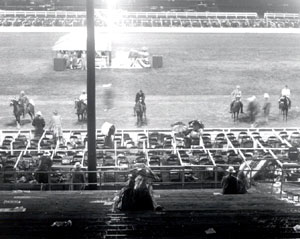
Walking Horse National Celebration
This annual summer event in Shelbyville, Tennessee, is one of the largest horse shows in the world. Its physical accommodations, including 1,650 stalls for housing horses, establish it as the largest equestrian complex in America. The “Celebration,” as the show is known, began in 1939 as a vision in the mind of Henry Davis of Wartrace, a longtime owner and trainer of Walking Horses. Davis witnessed a festival highlighting the crimson clover industry and wondered about the possibility of an event to celebrate the Tennessee Walking Horse.
After consulting with other owners, Davis asked for an opportunity to present his idea to the Shelbyville Lion’s Club. Later the Rotary Club joined the effort, and plans went forward for the first show, scheduled for September 7, 8, and 9, 1939. After the success of the first show, it continued as an annual event and now lasts ten days, ending the Saturday night before Labor Day. Since the first show, fifty-eight horses have been crowned “The World Grand Champion.”
From the very first, the idea of a “World Series” for Walking Horses captured the imagination of owners as well as the people of Bedford County. The community organized to establish a foundation for a horse show that has become a monument to both the horses and the people who have contributed to the show’s excellence.
The first show in 1939 drew 218 horses, mostly from Middle Tennessee. A decade later 610 horses entered the show. In 1996 the show attracted 2,170 entries from throughout the United States. Today’s owners come from as far away as Germany and Puerto Rico. The attendance at the first show numbered perhaps 2,000; the attendance at the show in 1996 was 150,390. The seating capacity of the outdoor arena is now over 30,000 for a single performance, excluding the Calsonic Arena, which accommodates another 4,500. The prize money for the 1939 show was $2,895; by 1996 it had reached $421,850. The economic impact of the Celebration is felt throughout the year in Shelbyville, Bedford County, and the mid-state area.
The Celebration is the centerpiece of the Walking Horse industry. To win an award at the Celebration not only enhances the value of the horse, but brings a feeling of unrivaled accomplishment to the rider and owner of the entrant. Winners can be assured that their accomplishment will be preserved in Walking Horse history.
The Celebration sets the standard for Walking Horse shows throughout America. The size of its ring–300 feet long by 150 feet wide–has become the standard used by promoters wherever horse shows are held. Its division of entries into special classes is accepted by most other shows. Children as young as six years old to senior citizens compete in separate age divisions for coveted prizes and honors. Such an age range not only adds variety to the show but also serves as a tribute to the temperament and easy gaits of the Tennessee Walking Horse.
Duels between great horses and rivalries among great trainers have punctuated the history and contributed to the excitement of the Celebration. During the Sweepstakes Class on final night, spectators rise to their feet in tribute as beautiful and talented horses make their way around the ring. After the horses and trainers exhibit their talents, the entries line up at one end of the ring and await the declaration of the “World Grand Champion,” which is followed by a victory ride around the ring.
The Celebration symbolizes many things: equine development, the establishment of a cultural tradition, and a successful economic experiment. Perhaps most of all, it symbolizes the ability of a community to focus its physical resources and imaginative leadership to establish a tradition that epitomizes the word “potential.”



